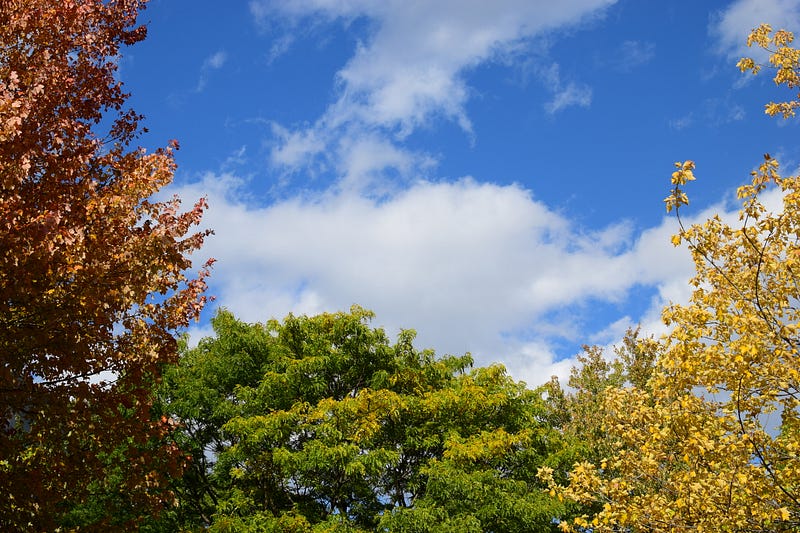Falling for Autumn Colors
Why and how vibrant, fall leaf shades are produced
By Claire Bohlig, Mechanical Engineering, 2023

Walking through Centennial Common on a bright autumn day, it is impossible to ignore the students in cozy sweaters taking photos of trees displaying a mosaic of reds, oranges, and yellows as the season changes.
These vivid colors are caused by the presence of three different types of pigments in aging leaves: chlorophylls, carotenoids, and anthocyanins. Chlorophylls, of type A and B, are the green pigments of photosynthesis and are produced in the chloroplasts of leaf cells. Since photosynthesis occurs in healthy leaves to provide the tree with food, leaves are green before they age. Once the leaf begins to die, it breaks down these pigments and reabsorbs the nutrients. Carotenoids are left over once the leaves lose chlorophyll and scatter yellow wavelengths. Anthocyanins are water-soluble pigments produced during metabolic processes in the leaf and scatter red wavelengths that lend color to red fruits and autumn leaves.
Colors are caused by the presence of three different types of pigments in aging leaves: chlorophylls, carotenoids, and anthocyanins.
Leaves change color as the relative amounts of the pigments present in the leaf change. Chlorophyll decreases right before the leaf falls in autumn, leaving behind any carotenoids and anthocyanins that had been produced in the life span. But unlike carotenoids, anthocyanins are produced right before the leaf dies, so there is a short period of time where anthocyanins are more present than chlorophyll, and the leaf turns brilliant red.
The mixing of pigments also occurs. When both anthocyanins and chlorophyll are present, the leaves are brown, and carotenoids and anthocyanins create bright orange. Even levels of anthocyanins within the same leaf tend to differ, resulting in ombre and spotted red leaves.
Leaves fall as the tree shuts down for winter, labelling leaves as nonessentials as it goes into the cold winter months. And as much as it pleases humans to see picturesque colors in the fall, trees must have a biological reason to paint landscapes in yellow, orange, and red.
It used to be universally accepted that color change was solely a result of chlorophyll leaving, and therefore the pigments had no biological function as colorants. However, in the 1990s it was suggested that color change must have some sort of evolutionary function for a tree; the puzzle is figuring out what.
In the 1990s it was suggested that color change must have some sort of evolutionary function for a tree; the puzzle is figuring out what.
There are two branches of science that try and answer this hypothesis. The first is physical explanations for vibrant leaf colors. One physiological explanation is that color change, and the production of anthocyanin, shields photosynthetic tissue in leaves from harsh light and cold temperatures in autumn. This allows the leaf to produce nutrients later in the season than if the chloroplasts (where nutrient production takes place) were exposed. Also, anthocyanins are strong antioxidants which would slow aging of the leaves and extend the life of the tree.
The second branch is that color change occurs for a biological reason. A change in leaf color could signal the tree as toxic to bugs that lay eggs on or animals that eat the trees’ leaves. Mainly this theory applies to yellow leaves and has been observed in birch trees. Trees that turned a more vibrant and prevalent yellow had fewer eggs and less consumption than trees that didn’t. An alternate explanation is that colorful leaves will signal for fruit eating birds to find, eat, and spread the berries or nuts of the tree. Most deciduous trees no longer bear fruit, but color change may be a residual biological response from when trees once did.
A few things affect if you can get that perfect fall color Instagram shot. First, summer drought stresses out trees and causes them to kill off leaves before color change begins. Second, anthocyanins (reds) require sunlight for production and are enhanced by cold, sunny days; crisp weather will ensure vivid red and orange foliage. Finally, rainy and windy weather during peak autumn days prematurely knocks leaves down, shortening the color display period.
With summers growing hotter and drier with climate change, it will become more and more rare to see vivid displays of color in autumn. If you’re lucky enough to live in Boston, or anywhere else with a fiery autumn, be sure to soak up the colors while you can.
Plant Physiology (2003), DOI: 10.1104/pp.103.027631
